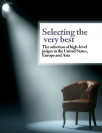This report, titled Selecting the very best: The selection of high-level judges in the United States, Europe and Asia, is a comparative study of judicial appointment practices across the globe.
The following is a review of how judges are selected in the United States and in a cross-section of European and Asian countries. The focus is upon the process for selecting the judges for the “Supreme” or highest court in each jurisdiction.
In sum, there is no “perfect” model for selecting judges for the highest courts of a country. The results that will be obtained by any particular model are highly dependent on the political and social context of a country—or state. A method that works well in a particular country might not produce desirable results elsewhere, which is why an analysis of the local context is always an essential starting point. That said, the analyses of the strengths and weaknesses of the selection methods adopted in the United States and in various European and Asian countries may be instructive in assessing what might work for any country considering efforts to enhance the effectiveness of the operation of the rule of law in that country.
At the end of this paper, we will elaborate on these points and make more detailed suggestions on the qualifications that are desirable for the justices of a nation’s Supreme Court. Ultimately, it is the quality of the justices that will best assure their independence, impartiality and effectiveness in enforcing the rule of law. Consideration should be given to promoting diversity on the Supreme Court, with a fair representation of women and differing ethnicities residing in the nation involved.
Read the full paper here.






